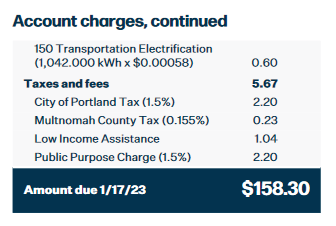Utilities 101: Understanding your Portland General Electric Bill (2023 Update)
Posted on January 25, 2023 by Charlotte Shuff
Tags, Oregon Utilities 101, Energy, General Interest

For many customers, understanding what goes into your monthly energy bill can be confusing. In this blog series, we will discuss how to understand your energy bill. This guide is for customers of Portland General Electric (PGE) who have standard bills. If you have opted into Equal Pay or Time of Use billing programs, your bill may look a little different.
Check out our other bill breakdowns under Oregon Utilities 101!
How to View Your PGE Bill
Many PGE customers receive physical bills in the mail. If you are one of these, viewing your bill is as easy as opening an envelope.
If you receive your bill electronically, you can access your bill by logging into your PGE account online at www.portlandgeneral.com. Once logged in, select “View Bill” and click “Download bill (PDF)” to see the full billing breakdown. Even if you receive your bill in the mail, you will also be able to view it online.
Anatomy of a PGE Bill
Page 1: This Month’s Bill
The first page is the basic information about this month’s. This includes your account information (name, account number, and address), as well as your bill for this month.
In the example, this bill is set to Auto Pay where the payment is made automatically on a set date. If you use Equal Pay or have another billing method, this might look a little different.

You can also see how your usage for this month compares to previous months with the graph below your account information. Below the graph, you can also see comparisons for how this month’s energy use compares to other months. For many customers, this information is all you need to know how much your bill is for the month.
If you want to look more deeply into the charges on your bill, move on to Pages 2-3.
Page 2-3: Overview of Your Charges

At the top, you can see your meter number. A meter is what tracks the amount of electricity you use at home. Most customers now have smart meters, which allow PGE to view their usage remotely. Some customers do not have smart meters and PGE sends someone to look at the usage amount in person. Either way, the number on your bill should match the number on your meter.
The schedule, or rate schedule, is specific to different types of customers. The schedule for residential customers is Schedule 7. Rate schedules lay out the prices utilities charge per unit of electricity for a given customer.
Note: For charges related to energy use, the amount of electricity you used will be measured in kilowatt hours (kWh). A typical PGE household uses about 800 kWh of electricity per month, though amounts vary between households.
There are three major categories of charges you’ll see on your bill:
- Energy Charges: Charges related to your household’s energy use, including the cost of the plants that generate the energy you’re using, the cost of getting the energy to you, and the administrative cost of providing your service. These charges only change every few years.
- Regulatory Charges and Credits: Charges or credits that are not included in the energy charges, including PGE’s fuel costs, and costs associated with recent events such as a natural disaster. These charges generally change each year.
- Taxes and Fees: Taxes and fees are charges tied to the customer’s municipality, like the City of Portland Tax, or statewide fees for consumers, such as Low-Income Energy Assistance. These funds do not go to PGE but rather are used to fund public programs, like those provided through the Energy Trust of Oregon.
These individual line items change depending on where you live, the type of billing you use, and if you have opted into additional programs. You can tell where you are receiving a credit if the line item says “CR” to the right of the dollar amount. All items without that label are charges on your bill.
Energy charges are the largest part of your bill. These charges are based on the energy you are using. The five categories are the same for all residential customers, though the amount will vary depending on how much electricity you used that month.
- Basic Charge: Same amount each month, covers administrative costs like customer service and billing, and fixed costs like the cost of the meter.
- Energy Use Charge: The cost of PGE’s generating electricity, including gas plants and renewable investments. For residential customers, there are two tiers of monthly energy use charges: a lower charge ($) for the first 1,000kWh (what most residential customers pay) and a slightly higher charge ($) for anything over 1,000kWh.
- Transmission Charge: the cost of bringing the energy from power plants to your area (building and maintaining equipment that transmits electricity over long distances)
- Distribution Charge: the cost of bringing the energy to your neighborhood from the energy grid (building and maintaining neighborhood power lines, transformers, and other equipment)
- (If opted in) Renewable Energy (Green Source, Clean Wind, Green Future Solar, or Habitat Support): programs to support renewable energy. Charges will only show up if you opt into the programs.
Regulatory Charges and Credits are generally small in total dollar amounts but are likely the largest in quantity of line items on your bill. These charges change annually based on PGE’s costs from the previous year and are approved by the Public Utility Commission. This could include the cost of building a new renewable power plant, investments in energy efficiency, costs associated with natural disasters, or other expenses outside of a household’s energy charges.
Taxes and Fees
- City/County Tax: Local governments charge an additional tax or fee, like the “City of Portland” in the example above. These additional charges vary depending on where you live.
- Low Income Assistance: A set $0.69 per month, as required by the state. These funds go to bill payment assistance programs that help households with low incomes who are struggling to pay their energy bills.
- Public Purpose Charge: This charge is equal to 3 percent of your bill. These dollars are dedicated to energy efficiency programs, market transformation programs, residential low-income energy efficiency programs, and residential low-income bill payment assistance programs.

Additional charges and credits may come from opting into certain programs, such as Peak Time Rebates, Community Solar, or if you own or rent solar panels that use net metering. These will show up under Taxes and Fees where applicable.
Call PGE customer service at 800-542-8818 to ask for an explanation of your adjustments. When talking to customer service, either ask for a full explanation of the adjustments or reference a specific line item on your bill.
Still have questions about understanding your bill? Call PGE’s customer service at 800-542-8818. Or contact CUB at .(JavaScript must be enabled to view this email address) or 503-227-1984.
Stay Up to Date on Oregon Utility Issues
CUB will continue to advocate for people in Oregon on major utility issues. Sign up for the CUB email list for the latest updates, action alerts, and news on policies that affect the utilities your home relies on.
To keep up with CUB, like us on Facebook and follow us on Twitter!





04/12/23 | 3 Comments | Utilities 101: Understanding your Portland General Electric Bill (2023 Update)